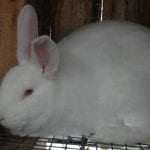Scientific Facts
| Common Name: | Pygmy Rabbit |
| Scientific Name: | Brachylagus idahoensis |
| Life Span: | 3 to 5 years |
| Size (Adult): | Small |
| Weight (Adult) | 375 to 500 grams |
| Habitat: | Areas with deep soils, dense bushes, and thickets |
| Body Shape: | Compact |
| Country of Origin: | United States |
Physical Description

The pygmy rabbit is a wild rabbit found in North America. It is one of the two rabbit species in the US that can dig its own hole or burrow. It is different from other wild rabbit species like the hare and the cottontail. A particular population called the Columbia Basin pygmy rabbit is included in the list of endangered species by the US Federal government; however, the International Union for Conservation of Nature lists is as a species of least concern.
The pygmy rabbit body size is smaller compared to any other leporid in North America. The rabbit’s hind legs are too short while the hind feet are broad and very hairy. It has very short ears which are rounded with dense hairs found inside and outside the ear.
The pygmy has black and white whiskers while the tail is small and hardly seen as the animal moves about. The upper parts of this rabbit are buff-gray, while the back of the neck and anterior areas of the legs are buff-cinnamon. During the winter season, it wears a silver-grey coat. It has a small skull, small teeth, and has a total length of 232 to 305 millimeters.
Distribution and Conservation
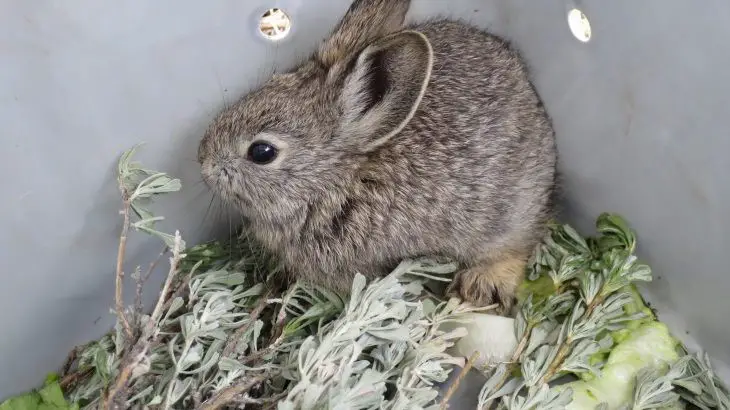
The pygmy rabbit is found mostly in the Great Basin and other adjacent areas in western North America. This breed is also found in southwestern Montana, west to southern Idaho and Oregon, Utah, Nevada, California, and east-central Washington and Wyoming.
Purebred pygmy rabbits have been extinct. The last male Columbia Basin pygmy purebred that is found only in the Columbia Basin in Washington State died at the Oregon Zoo in Portland in 2006. Meanwhile, the last purebred female died two years after. The Oregon Zoo has conducted a crossbreeding program together with the Washington State University and the Northwest Trek. The goal of this program is to preserve the Columbia Basin pygmy rabbit by breeding surviving females with male Idaho pygmies.
Fast Facts
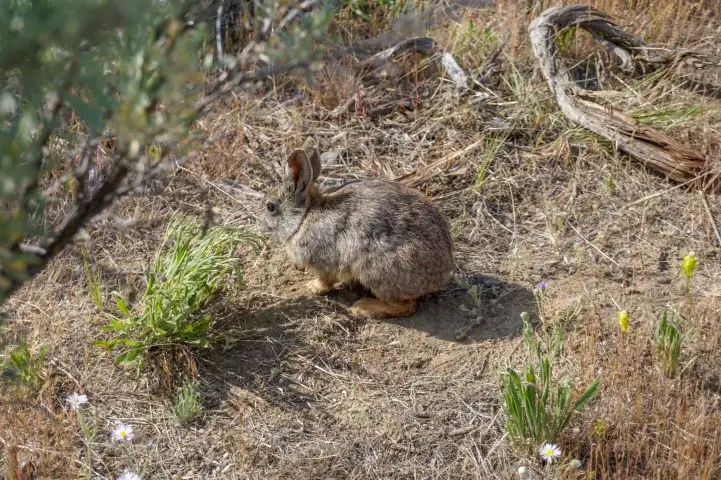
The pygmy rabbit is known as the only leporid in North America that can dig its own burrow. Juveniles pygmy rabbits use burrows more than adults and very young rabbits. Also, early reproductive activities of adult pygmies may be done in burrows. When male and female rabbits can use sagebrush as cover, then they don’t need to use the burrow anymore.
A pygmy rabbit’s burrow is very important, especially during the winter. The rabbit uses the burrow to keep it warm. The hole is not as simple as it may look from the outside; inside are tunnels that widen and form chambers that can be as deep as a meter. Usually, burrows have 4 to 5 entrances, and the most could have ten.
Reproduction
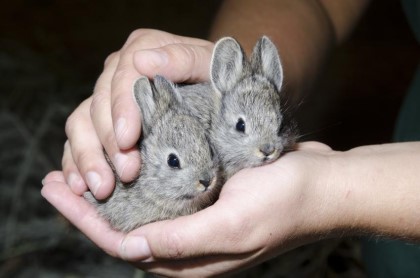
Pygmy rabbits are able to breed when they are a year old. The breeding season is short. In Idaho, it starts March and ends May. In Utah, the breeding season starts February and ends March. The gestation period is unknown, and the female can lay from 3 to 6 babies in a litter. Around three litters are born per female year after year.
Pygmy rabbits have varying growth rates, and it depends on a baby’s date of birth. Babies from early litters may grow larger because of their longer developmental periods that usually start on their first winter. Mortality rates in adults are the highest during late winter and in the early spring.
Pygmy rabbits are active all day but are most active during dawn and dusk when its cooler. They tend to remain inside their burrows when the sun is hot or during midday.
Fun Facts
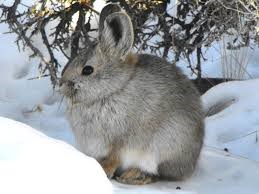
Pygmy rabbits are wild species of rabbits, but some breeders have to develop domesticated pygmies. These rabbits are known to be good pets but need early and regular training and interaction because these tend to become skittish and shy. To train naturally wild, although domesticated rabbits, be very patient and use food or treats to woo them. But do so slowly. Once the rabbit understands that you’re no threat, they will develop a trusting relationship with you.
Personality and Behavior
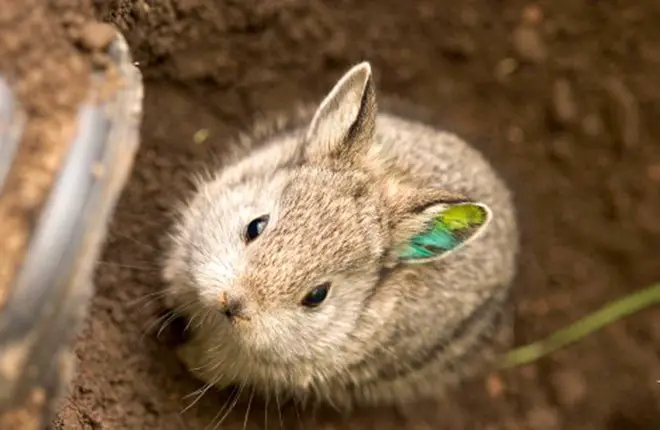
Wild pygmy rabbits burrow in loose soil and create chambers, tunnels, and areas where it remains, especially during the hot days and cold winters. It does not hibernate and just rides the winter using smart survival techniques. It is the master of sagebrush life, and it knows where to get food and where it can dig more holes and tunnels.
Pygmy rabbits will eat anything near its area and won’t venture far to look for food in fear of predators. Because of its small size, it is prey to many predators, including weasels, coyotes, red foxes, bobcats, badgers, and owls. The color of the pygmy rabbit is also one of its smart ways to avoid predators. It will hide inside thick sage brushes and won’t cross open areas for food as well.
Meanwhile, domesticated pygmy rabbits are tame, sweet, and friendly, but as mentioned, it takes a lot of time and patience to train a naturally wild rabbit to become like this. And similar to its natural behavior, domesticated pygmies need companions as well. You must house it together with other domesticated pygmies for the rabbit to develop good social behaviors.
This may not be a good first-time pet, especially for young children, because these may become nervous when handled incorrectly. A good candidate for an owner is an experienced individual who can provide the best care and attention to its many needs.
Care of Pygmy Rabbits

Consider yourself lucky if you happen to have the chance to take care of a pygmy rabbit because this is a rare breed. But we must caution you; this breed is tricky to take care of because even if you have a captive-bred specimen, chances are, its natural wild side will still shine. But nevertheless, providing the utmost care, love, and attention is key to the survival of this rare breed.
Taking care of a Pygmy Rabbit is like caring for other rabbit breeds. Make sure you’re your pet has the correct diet, housing or enclosure, companionship, and medical treatment.
An important part of a captive rabbit’s diet is hay. Hay is the bulk of a rabbit’s diet, but you may also feed these rabbits commercially-made food or pellets. Commercially-prepared formulas have added vitamins and minerals for your pet’s good health. You may add vegetables, and fruits for a well-rounded diet, just make sure to cut these up nice and small.
Provide your pets unlimited fresh water and hay. Hay is rough and is helpful in keeping their digestive tracts regular and healthy. Put water in a heavy shallow dish so your rabbit can easily drink. The dish must be heavy so your rabbit won’t knock this over as it moves around its enclosure. An inverted water bottle with a spout at the end is also a good way.
Be sure that your pet is eating the right kind of food. Avoid food laced with pesticides, toxins, and herbicides by giving it organic fruits and vegetables. Younger rabbits may eat alfalfa hay. This is rich in calcium, which is a mineral needed for growing bones. Meanwhile, adult Pygmy Rabbits will do well with legume hay.
Captive-bred Pygmy Rabbits are lovable pets, but you must train it well to tame its wild nature. Interact with your pet rabbit by playing with it. Even wild rabbits are social animals and thus will need companions aside from interacting with their owners.
Pygmy Rabbits will groom themselves to the point that it will take hours before it’s over. Rabbits may also be seen grooming each other, and some say that this or a way for them to bond. Also, mother rabbits may also be seen grooming her kits when she is in the nest.
Pygmy Rabbits are mostly active in the daytime and tend to sleep in the evenings. This is why you must feed your pet Pygmy Rabbit in the morning when they are most active. Captive rabbits sleep 8 hours a day and may sleep huddled together for warmth. When constructing a cage or enclosure for your pet rabbits, create a large area where they socialize, play, eat, and sleep.
Supplies and Cages
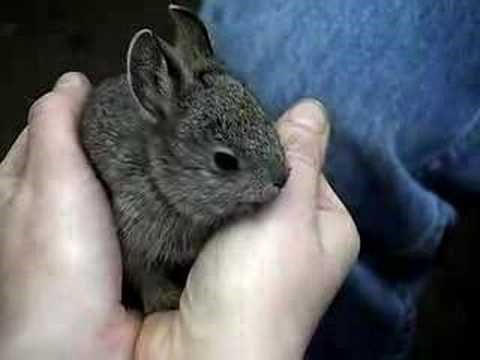
The enclosure should be made of wire and have a strong wooden or metal frame. The bottom should be removable because this is where the rabbit’s droppings will easily fall. This makes it easier to clean the cage. The floor of the enclosure should be lined with soft bedding so that it is comfortable for your rabbit to remain on.
Install a rabbit hay feeder on the side of the enclosure. Fill this with hay so your rabbit can eat when it feels hungry or chew hay when it is boring. For the cage bedding, you may use hay, wood pellets, or pelleted horse bedding. You may have some newspapers, paper towels, or brown paper bags, but these can have prints or inks which can be toxic to your pets, and of course, these can easily tear and won’t be good cage bedding.
To clean the enclosure, remove your pets first and place these inside a safe and clean enclosure or just set these free in a fenced area. Use only a safe cleaner or natural cleaning product like white vinegar, baking soda, or lemon juice. Never use household cleaners, bathroom cleaners, tile cleaners, or household bleach because these may have toxic ingredients that can be dangerous to your pet’s health.
Consider having a separate or extra cage if you want to breed baby Pygmy Rabbits. Baby pygmies are born naked, deaf, and blind. These need a safe and warm enclosure to keep their bodies at the right temperatures. Use a smaller cage with a cage lamp or lighting to keep kits dry, warm, and safe.
Remember, Pygmy Rabbits will love chewing on things. If these are kept indoors, these will chew on anything that’s made of wood like wooden walls, fixtures, and furniture. This rabbit can also chew on electrical wiring and may end up electrocuting themselves. To avoid accidents, provide hay or chew toys inside the cage. Rabbit-proof your home before releasing your pet rabbit inside or outdoors. Pygmies also love to burrow, and it may do so in your garden or yard. This is their natural behavior, so unless you have a landscaped yard or garden, just let them be and just make sure to fence the area.
Health Concerns

A Pygmy Rabbit is a healthy breed and is not affected by any disease. The most common conditions that the Pygmy Rabbit may be affected with are pests like lice, mites, ticks, and fleas because these are naturally found in their environment.
Meanwhile, this species of the rabbit is not immune to common rabbit diseases. This is why you must always monitor your rabbit’s health and temperament because any change could be due to an illness. As early as your pet is able to open its eyes, take it to the vet for vaccinations and tests.
Tests will assess the overall health and development of your rabbit. Take note that small rabbits may have sensitive digestive systems and could be prone to different health conditions such as enteritis, bloat, and stasis. These conditions. A vet can rule out these conditions or treat these as soon as possible.
Also, watch out for ear or fur parasites. The most common pests are mites, fleas, and ticks. Rabbits that are affected by these parasites are the ones that are raised with poor hygiene and are kept in dirty and unkempt surroundings and enclosures.
Check for signs of illness such as poor appetite, nasal and eye discharges, diarrhea, constipation, and vomiting. Consider an unsteady gait, restlessness, grating of the teeth, and sleeping for extended periods signs of a serious condition. Your pet should see a vet at once.
Another very important thing is deworming. Your Pygmy Rabbit should be treated for worms at least once a year or twice a year. This should be done during spring and fall. Deworming is a major concern, especially with rabbits that come from the wild or are bred from wild parents. You may use a deworming paste; just a pea-sized amount will do. Place this in the rabbit’s mouth, and it will continuously lick and swallow the medication. Follow the dose according to the product information for the best results.
Dental Care
A rabbit’s teeth will continue to grow and grow w to extreme lengths. Overgrown teeth can pierce the mouth and gums, causing too much pain and discomfort. You must make sure that the rabbit’s teeth don’t overgrow.
You can help your rabbit by offering hay because this grinds the rabbit’s teeth naturally as it chews. You may place pieces of wood, baskets made of wood, and other cage accessories that can help file rabbit’s teeth.
Spaying or Neutering
Rabbits are naturally promiscuous and can breed many times a year; therefore, as a responsible pet owner, you need to control this by spaying or neutering their pet or pets. Unless you’re breeding pygmies, then this should be done as soon as your pet reaches the ideal age.
Spaying and neutering are done at a young age, but some vets wait until the rabbits are six months old to be safe. Some vets neuter bucks as young as three months. For questions about spaying and neutering and for aftercare post-surgery, consult your vet.
Grooming

Pygmy Rabbits have short furs, but nevertheless, it will need regular grooming. Brush the fur to keep it clean, shiny, and pest-free. Use a small brush and groom at least once or twice a week.
Grooming must be done more frequently during the molting period, to prevent wool blocks and to keep the rabbit from eating their fur. The fur is non-digestible and can accumulate in the digestive tract causing blockage and further complications. Removing excess fur at once by grooming can significantly reduce wool block.
If your rabbit is dirty, don’t give it a bath because this stresses it. You may use a damp towel to spot clean any kind of dirt. Just wipe the rabbit down with a damp towel and use a dry one to finish drying it.
Trim your rabbit’s nails monthly and check its mouth for overgrown teeth. You must also clean the rabbit’s ears. If your rabbit is skittish, take this to the vet for proper cleaning and cutting of its nails and teeth.
Availability – Where to Get One?
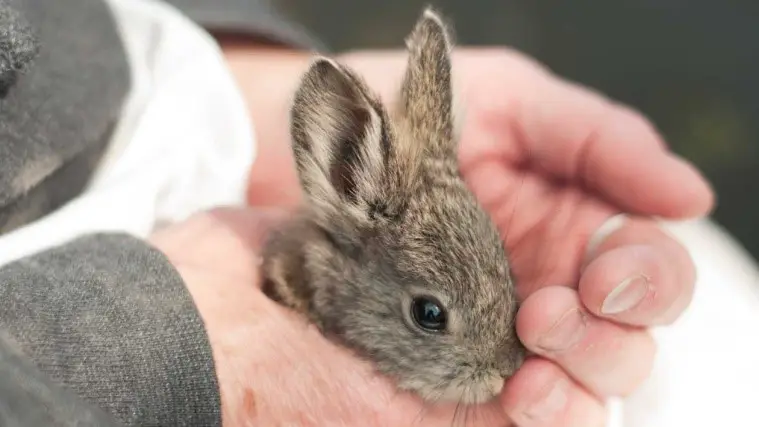
You won’t be able to find a Pygmy rabbit in pet shops and stores online or offline because this is a rare and near-extinct species of rabbit. You might get lucky by visiting its natural habitat and finding rabbits in the wild, BUT we don’t recommend this. You may only pet a captive-raised bunny and never a wild specimen.
How to Care for a Pygmy Rabbit
This is a summary of how to care for a Pygmy Rabbit breed. Again, we recommend leaving this rabbit to the care of people who are patients and experts in caring for endangered species! This is solely for information only.
Caring for a Pygmy Rabbit is just like caring for other rabbit breeds. There are four basic components of a captive rabbit’s care: the right diet, housing, companionship, and medical care.
The main food of captive-bred rabbits is hay. Hay is very important because the rabbit can chew this to grind their teeth, to keep their digestive system healthy, and to maintain regular bowel movements. You can feed it commercially-prepared pellets designed for rabbits, vegetables, and fruits for a well-rounded diet. You may also give them food that is found in their natural habitats such as grasses, twigs, birch, roots, and weeds.
Place fresh water and hay inside the rabbit’s cage. Hay is rough and is perfect in keeping their digestive tracts regular. Replace the water every day and place it in a large, heavy shallow dish so that your rabbit can drink from it and won’t knock it over as it moves inside the cage.
Take note that captive-bred rabbits may still have their wild rabbit behavior, and this can only become calm, friendly, and docile when you take time to train it. Train and interact with your pet daily to gain its trust and avoid wild behaviors. Also, captive rabbits are social animals and will need a rabbit companion or companions.
If you don’t have the resources, space, and patience to care for two or more rabbits, then a rabbit (any breed of rabbit) is not the pet for you. Your pet can grow healthy, develop a good temperament, and have a docile behavior when it socializes with cage mates and with you.
Take your pet to the vet because it needs vaccinations, tests, and a clean bill before it can socialize with other rabbits and with you and your family. Take note of the many different signs of illness in rabbits to take it to the vet for proper care if you spot any of these.
FAQs
Are Pygmy Rabbits carnivorous?
These rabbits are not carnivorous and are herbivores, which means that these won’t eat meat at all. In the wild, a Pygmy rabbit will only consume plants or plant parts such as roots, leaves, flowers, twigs, stems, seeds, and more. And in captivity, these can eat rabbit pellets, fresh fruits, vegetables, and hay.
What do Pygmy Rabbits eat?
Pygmy Rabbits are herbivorous, and it will eat plants. These will eat all plant parts such as roots, bark, seeds, weeds, flowers, and leaves, and in captivity, it can consume rabbit food or pellets, vegetables, and fruits, but hay has to be at least 70 to 80% of their diet.
Should you take a wild rabbit from the forest?
Never pick a wild animal such as a wild Pygmy rabbit from the forest. You can’t tame it, but you won’t be able to make it a docile, friendly, and calm pet because it will remain wild. If you see a wild injured rabbit, you may call animal services for help right away.
Are Pygmy Rabbits endangered?
Yes, Pygmy rabbits are endangered. But efforts are being made to preserve the last remaining rabbits by breeding wild Pygmies with other wild dwarf rabbit species.
Can Pygmy Rabbits swim?
Yes, Pygmy rabbits can swim just like other breeds, but it won’t be as good as other water animals. However, rabbits should not get wet because this stresses them a lot.
How do you tame a rabbit?
A wild rabbit cannot be tamed, and we don’t recommend this because you might get bitten or hurt. However, you can train a captive-bred rabbit instead because these rabbits have a docile behavior and are calmer than wild rabbits. These may still need constant handling and interaction with their handlers to remain tame even in captivity.
Does it hurt when a Pygmy rabbit hits you with its hind legs?
Yes, despite its size, Pygmy rabbits have sharp nails, especially on its hind feet. This can kick very hard with its hind feet, which can inflict scratches and marks. The rabbit will only do this when it feels threatened or afraid.
What to do when you see abandoned baby rabbits?
If you’re certain that wild babies are abandoned, contact animal service. You should never get baby rabbits from the wild or touch them because these may bite you.
Where do Pygmy rabbits live?
Wild Pygmy rabbits live in burrows or holes. They burrow in the ground, up to a meter deep and create tunnels, chambers, and holes where they live with other rabbits. They may have several entrances to allow them to move quickly from one place to another without being spotted by predators.
Can you keep a Pygmy rabbit as a pet?
Yes, you can keep a tame, captive-bred Pygmy rabbit as a pet because. It is a pet for families but not for families that have small children because of the size of this rabbit breed. Constant training and a lot of patience are needed to tame this breed.
Will Pygmy rabbits eat fruits and vegetables?
Yes, Pygmy rabbits can eat fruits and vegetables in captivity. Aside from these, you may also feed it commercially-prepared pellets or rabbit food, which contains nutrients that the rabbit needs daily.
Will Pygmy rabbits eat their poop?
Yes, just like all rabbit breeds, Pygmy rabbits will eat their poop because these still have nutrients. But after eating their poop once, it won’t be ingested the second time. It is still unknown why rabbits do this, but you can prevent this by removing their droppings as soon as you spot them.
Can you keep two or more Pygmy rabbits inside a cage?
Yes, you can keep two or more rabbits in one cage as long as their cage is large to keep them in. Despite the small size of a pygmy, their cage must be large, comfortable, and safe so your rabbit or rabbits can live comfortably.
How do you clean a Pygmy rabbit’s cage?
Remove the rabbit from the cage first and place it in another clean cage. Remove the pan where poop is found and dispose of the droppings properly. Use a hose, brush, and cleaning product to clean the cage walls, bottom, accessories, and toys. Make sure that everything is dry before placing your pet inside the cage.
How do you take care of baby Pygmy rabbits?
To take care of baby Pygmy Rabbits, put the kits in a comfortable and warm enclosure. Feed this soft, pureed food, and keep these safe and warm. Protect baby rabbits from predators also from domesticated cats or dogs. For wild bunnies, call animal services to have these rescued and cared for properly.
Can you leave a Pygmy rabbit indoors or inside your home?
You may allow a rabbit to remain indoors but only under your constant supervision. Use a portable perimeter fence to protect areas that are off-limits to your pet. You must rabbit-proof your home before you let your rabbits lose.
Do you place a Pygmy rabbit’s cage indoors or outdoors?
This may depend on your preference. You may place the cage indoors to protect it from the elements, but this may have a limited area and may not be enough even for a Pygmy rabbit or rabbits. When you construct a cage outdoors, the rabbits may need to bear the cold, but at least they will have a large area for socializing, playing, and running.
How large should a Pygmy rabbit’s cage be?
A Pygmy rabbit must be placed in a large enclosure because, despite its size, it is active and needs a large area to play and run. For two rabbits, double the size of this area. You must never overlook the size of the enclosure and be sure that your rabbits have enough space to play and sleep.
What happens when the teeth of the Pygmy rabbit grow longer?
When the teeth of a rabbit grow longer, these can pierce its mouth and gums, causing extreme pain, and this can also affect its appetite. This is why your pet rabbit must see a dentist as soon as you can. You can help by feeding it hay since this can grind their teeth shorter as it chews.
Can Pygmy rabbits escape their cages?
Yes, Pygmy rabbits can escape their cages by burrowing, especially if the cage is outdoors. You must create deep posts and walls so the rabbit can’t dig through it.
Are Pygmy Rabbits territorial?
Just like any rabbit, Pygmies may become territorial when these are kept in a small cage or enclosure. Males may also develop aggressive behavior, especially in the breeding season. Dominant males can bite, scratch, and kick their opponents to establish hierarchy.
Do you need to place a heater inside a Pygmy rabbit’s cage?
You may use a cage lamp to provide heat inside the cage. But in extremely cold climates, you can use a small portable heater and place this near the rabbit cage for in a nesting cage to warm baby rabbits.
Will a rabbit eat their young?
Some rabbit species can eat their young, and breeders are still wondering why this is happening, but some say that it could be due to poor food and water supply inside the cage or as a way to prevent predators from discovering the nest. Mother rabbits may eat her young when they are stillborn.
Can rabbits survive the cold?
Yes, rabbits may stay in the cold and survive it by foraging food that’s under the snow. Rabbits can use their short legs to dig out snow and eat roots, shrubs, berries, and any kind of food that they can find.
Can Pygmy rabbits remain outdoors?
A pet Pygmy rabbit may be allowed to stay outdoors, but you must rabbit-proof your yard first. A portable perimeter fencing on top of a cement floor or pavement is a good set up because this rabbit can dig its way out of a cage if it is set on top of soil or ground.
Can you prevent a Pygmy rabbit from eating his poop?
You can stop a rabbit from eating its own poop by removing the droppings right away after these defecate. But since you cannot watch your rabbits 24/7, these animals will still eat their droppings because they know that it still has nutrients in them.
Are all rabbits cannibals?
Eating their young may be observed in some rabbit breeds. Experts say that this happens because the female is hungry or thirsty after giving birth. Also, this is a way to remove any traces of tissue, blood, and smell in the nest when a baby rabbit is stillborn.
How young do you spay or neuter a pet rabbit?
This may depend on the vet’s assessment as to when to spay or neuter a rabbit. Some bucks are spayed as young as 3 months, while some vets will wait until these are 5 to 6 months.
How many rabbits can you keep as a pet?
It depends on you. You can keep three or more rabbits as a pet as long as you have a large cage or enclosure to keep these rabbits comfortable and happy. Keeping only one rabbit will make it lonely, and this can affect its health.
Can rabbit diseases affect humans?
Some rabbit diseases can affect rabbits only while some are dangerous to humans. If your rabbit is sick, take it to the vet as soon as you can. You must check for the different signs of illnesses such as poor appetite, diarrhea, constipation, sneezing, difficulty in breathing, and any change in behavior.
Do Pygmy rabbits have good hearing?
Despite the Pygmy rabbit having smaller ears than other rabbit breeds, this species has good hearing. It can hear its predators from afar, and this allows them to escape quickly.
Can rabbits see in the dark?
Yes, rabbits have excellent vision, especially at night. This is why some species prefer to look for food or forage during twilight. Rabbits like the Pygmy Rabbit also have a good sense of smell and hearing to recognize predators near the area.
Can you train your rabbit to wear a collar and walk on a leash?
Some pet owners have been successful in training their pet rabbits, especially large rabbit breeds, in wearing a collar and a leash, but some say that it can take time to do this and may also depend on what breed of rabbit you have.
Will Pygmy Rabbits recognize their owners?
Some rabbit owners say that their pets can recognize them and can tell if they are being handled by their owners or by a stranger.
Can pet rabbits tolerate children?
Some rabbits are skittish and don’t want to be held by adults and young children. Some are calm, docile, and friendly and won’t mind being held and petted even by young children.
Will your pet rabbit survive a cold night?
Some rabbits can survive the cold winter season and will simply find food under the snow. Some rabbits can also change their fur color and texture to adapt to the winter weather and as protection from predators.
Can you place the cage of Pygmy rabbits near other rabbit pets?
Yes, you can do this and because this is the setup in most pet shops and stores.
Will rabbits eat insects?
Rabbit won’t eat insects. This animal will eat only plant and plant parts in the wild and will eat commercially—prepared food or pellets, fruits, and vegetables in captivity. Make sure to provide organic produce to avoid chemicals and toxins that can affect your pet’s health.
Where do wild rabbits sleep?
In the wild, rabbits may sleep in burrows. They dig holes as deep as a meter to remain there all day. Rabbits may create holes, chambers, and dens to accommodate a group of rabbits and should be safe and to become secure from predators.
How often do rabbits should visit the vet?
Rabbits should visit a vet at least once or twice a year. Young rabbits must also be vaccinated against rabbit diseases early, and they need to have an initial visit when they are just a few weeks old.
Are Pygmy rabbits bites dangerous?
Yes, Pygmy rabbit bites and the bite of all rabbits are dangerous as well because this may have rabies. Also, the rabbit teeth can be long and sharp and can easily tear off the flesh, which can lead to an infected wound.

